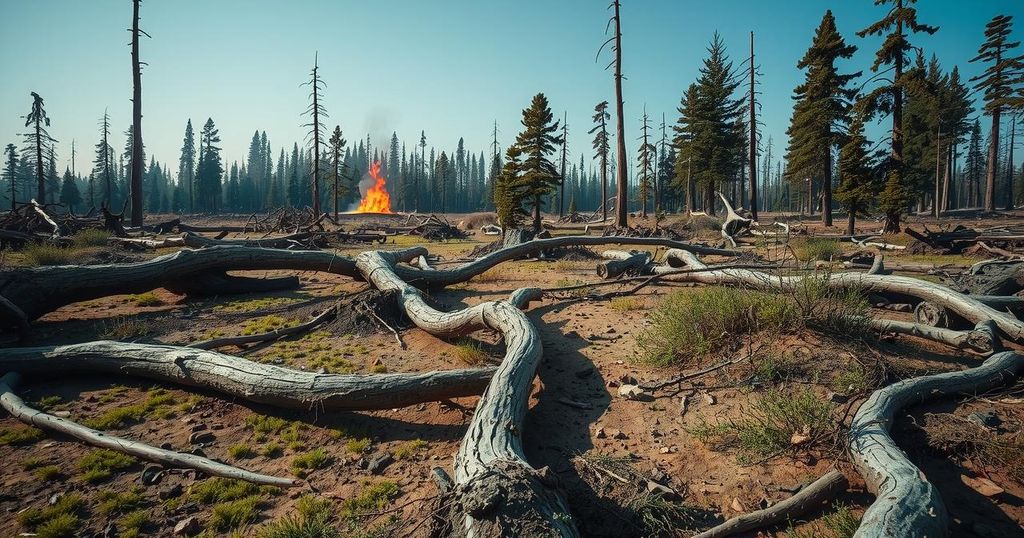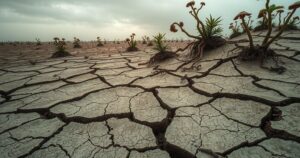Impacts of Hurricane Helene and Its Connection to Increased Wildfire Risk

Hurricane Helene significantly damaged regions in Virginia, Tennessee, and North Carolina, heightening wildfire risks due to downed vegetation. Experts emphasize that while fire can promote ecosystem health, the abundance of dead material poses new challenges for fire management. Seasonal forecasts anticipate an above-average hurricane season, underscoring the need for community preparedness and awareness.
Last fall, Hurricane Helene caused unprecedented devastation in Southwest Virginia, Northeast Tennessee, and Western North Carolina. Many communities are still in recovery months later, as the storm’s aftermath poses residual threats, particularly increasing the likelihood of wildfires due to downed vegetation and debris. Michele Steinberg, Wildfire Division Director at the National Fire Protection Association, noted that Helene’s impact has undoubtedly altered local wildfire risk patterns.
Steinberg emphasized that fires can play a beneficial role in ecosystems, as they help to return nutrients to the soil and clear dead growth. She explained, “Fire on the landscape does all kinds of beneficial things like returning nutrients to the soil, getting rid of dead growth and undergrowth… It helps clear the land and encourages certain species to grow.”
In regions like the Northeast and Mid-Atlantic, spring and fall are when wildfires are most likely due to dry conditions. These conditions can arise even with residual snow, as dead material on the ground can ignite if enough heat is introduced. Steinberg warned that urban areas also risk becoming fuel for wildfires when normal vegetation is compromised.
Hurricane Helene generated additional fuel for potential wildfires by uprooting trees and shrubs. This results in a significant increase in dead material, which, when dried, can create intense fires. Steinberg cautioned that increased wildfire intensity could strain emergency services as they divert resources to recover local infrastructure rather than managing fires.
Following Hurricane Helene, communities quickly recognized the elevated wildfire risk and raised awareness early on. Western North Carolina has already experienced severe wildfires this spring, a phenomenon that aligns with historical patterns in the area. Ignition sources, coupled with ample dead material, can lead to rapid fire spread.
Steinberg advised residents to stay informed about wildfire conditions. Understanding terms like “Red Flag Warning” from weather agencies can be crucial, as these indicate precarious conditions for wildfires. She explained, “What they mean is, we have conditions right now… those are the three big ingredients that if you have fuel and an ignition, you’re likely to have a major fire start and spread quickly.”
Homeowners can take preventive measures, such as managing debris within five feet of their homes, where embers from wildfires can land. Steinberg highlighted that the National Fire Protection Association offers resources for preparedness, encouraging communities to participate in the Firewise USA program to enhance neighborhood safety against wildfires.
Looking ahead, Colorado State University’s recent seasonal forecast suggests 17 named storms for the 2025 Atlantic hurricane season, with predictions of nine hurricanes and four major hurricanes. Levi Silvers indicated warm sea-surface temperatures and the ongoing weak La Niña event as factors contributing to this forecast, alongside traditional correlations to above-average hurricane activity. The Atlantic hurricane season extends from June 1st through November 30th, emphasizing the need for continued vigilance in preparation and response efforts.
In conclusion, Hurricane Helene’s impact has created ongoing challenges for communities as it increases wildfire risks due to downed vegetation. Awareness of natural fire cycles and preventive measures can help mitigate these risks. Additionally, forecasts for above-average hurricane activity remind us of the importance of preparation for future disasters. Communities must remain vigilant and proactive in maintaining their environments and supporting emergency readiness.
Original Source: www.wvtf.org






